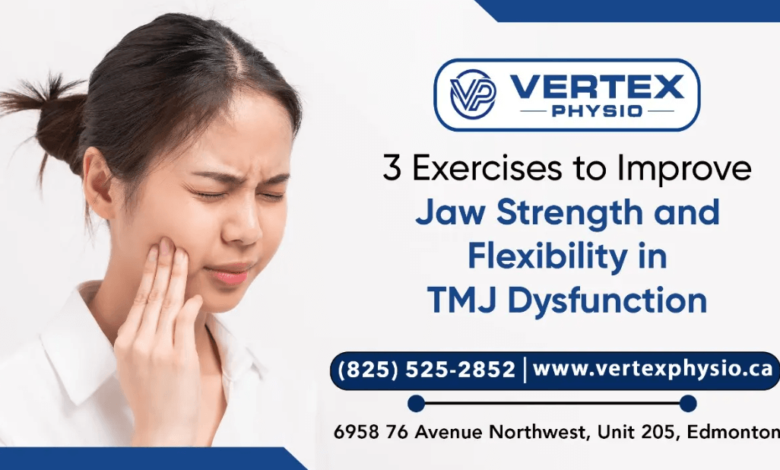3 Exercises to Improve Jaw Strength and Flexibility in TMJ Dysfunction

TMJ—Temporomandibular joint dysfunction presents a range of uncomfortable symptoms, from jaw pain, ear pain and difficulty chewing to clicking sounds when moving the mouth. These issues arise from problems with the muscles and joints that control jaw movement. To manage TMJ pain effectively, specific exercises designed to improve jaw strength and flexibility can be tremendously helpful. TMJ Dysfunction physiotherapy in Edmonton focuses on targeted movements that enhance the functionality of the temporomandibular joint, aiming to alleviate the symptoms associated with TMJ dysfunction.
These three key exercises are fundamental in temporomandibular joint physiotherapy, offering relief and increased mobility for those suffering from temporomandibular joint disorders.
1. Jaw Relaxation Exercise
Jaw relaxation exercises are fundamental in reducing tension and promoting relaxation of the jaw muscles, which is crucial for individuals experiencing TMJ dysfunction. This exercise targets the muscles around the temporomandibular joint, helping to alleviate pain and improve overall function.
How to Do It: Begin by sitting or standing with shoulders relaxed to ensure the body is in a comfortable and tension-free posture. Slowly open the mouth in a controlled manner, focusing on smooth and deliberate movements. While opening the mouth, gently rest the tip of the tongue on the mouth’s upper roof, directly behind the upper front teeth. This tongue placement helps to stabilize the movement and ensures the jaw muscles are relaxed during the exercise. Hold this position for a few seconds, maintaining the gentle opening of the mouth. After holding, slowly close the mouth again in a controlled manner. This exercise should be repeated 5-10 times daily to maximize its benefits in reducing muscle tension and promoting relaxation.
2. Resisted Mouth Opening
Resisted mouth-opening exercises are designed to strengthen the muscles that help open the jaw, thereby improving both strength and mobility. This exercise is particularly beneficial for enhancing the functional capacity of the temporomandibular joint.
How to Do It: Start by placing a thumb or two fingers under the chin to provide a source of light resistance. Slowly open the mouth while gently pushing against the chin with the thumb or fingers. The resistance created by the hand ensures that the muscles have to work harder to open the mouth, thereby increasing their strength. Hold the mouth open against this resistance for 3-5 seconds. After holding, slowly close the mouth while continuing to apply resistance with the hand. This controlled movement is crucial for gradually building muscle strength. Repeat this exercise 5-10 times per session to progressively enhance the strength and mobility of the jaw muscles.
3. Resisted Mouth Closing
Resisted mouth-closing exercises focus on the muscles involved in closing the jaw, helping to balance the muscle activity around the temporomandibular joint. This exercise ensures that the muscles responsible for jaw closure are strengthened and function efficiently.
How to Do It: Place the thumbs under the chin and the index or middle fingers on the area between the lower lip and chin. This positioning of the hands provides the necessary resistance for the exercise. Apply gentle resistance with the hands as the mouth is slowly closed. The resistance forces the jaw muscles to work harder to close the mouth, which helps in building their strength. Hold the closed position for a few seconds while maintaining the resistance. After holding, release the resistance and allow the mouth to open again. Perform this exercise 5-10 times per session to effectively strengthen the muscles responsible for closing the jaw and to ensure balanced muscle activity around the temporomandibular joint.
Incorporating Heat and Ice Therapy
In addition to exercises, incorporating heat and ice therapy can significantly help manage TMJ symptoms. Heat therapy involves applying a heating pad to the jaw area, which helps relax tight muscles and improve blood flow to the region. This increased blood circulation can aid in the healing process and provide relief from stiffness and discomfort. Conversely, ice therapy entails applying a cold pack to the affected region, which can help reduce inflammation and sharpen the pain. The cold constricts blood vessels, decreasing swelling and providing an analgesic effect. Alternating between heat and ice as needed can offer comprehensive relief, typically applying each for 15-20 minutes at a time. This method can be more effective when done several times a day, especially after performing jaw exercises.
Self-Massage Techniques
Self-massage is an effective technique for alleviating muscle tension around the jaw, which is often associated with TMJ dysfunction. Gently massaging the masseter and temporalis muscles, located around the jaw and temples, can help reduce pain and improve muscle flexibility. Using the fingertips, apply gentle circular motions to these areas for about 5-10 minutes daily. This helps to release tension, increase blood circulation, and promote relaxation of the jaw muscles. Consistent practice of self-massage can complement other TMJ treatments and exercises, enhancing overall relief from symptoms.
When practiced regularly and incorporated into comprehensive programs in TMJ physiotherapy in Edmonton, these exercises can significantly help manage the symptoms of TMJ dysfunction.
Read also: Health Risks and Side Effects of Blue Xanax Abuse
Strengthen Your Recovery with Physiotherapy
At Vertex Physiotherapy, we understand the challenges associated with temporomandibular joint disorders (TMJs). Incorporating exercises to enhance jaw strength and flexibility is a crucial part of managing TMJ dysfunction.
If you’re struggling with TMJ dysfunction and looking for targeted support, consider consulting with a specialist at Vertex Physiotherapy. We are dedicated to helping you achieve better jaw function and overall quality of life through personalized programs in TMJ physiotherapy in Edmonton. Contact us today to learn more about how we can assist in your journey to recovery from TMJ dysfunction.




